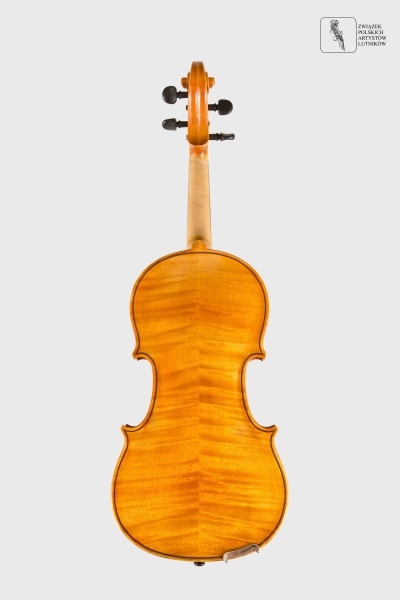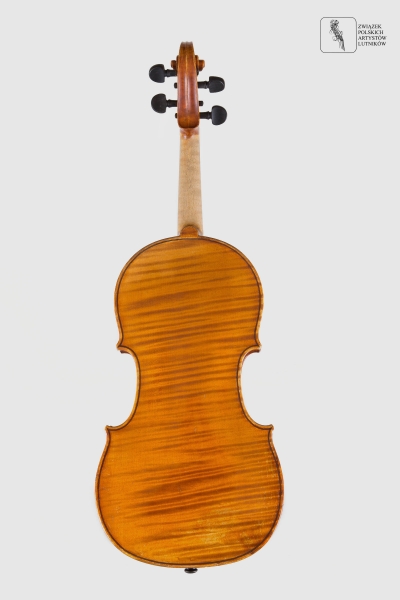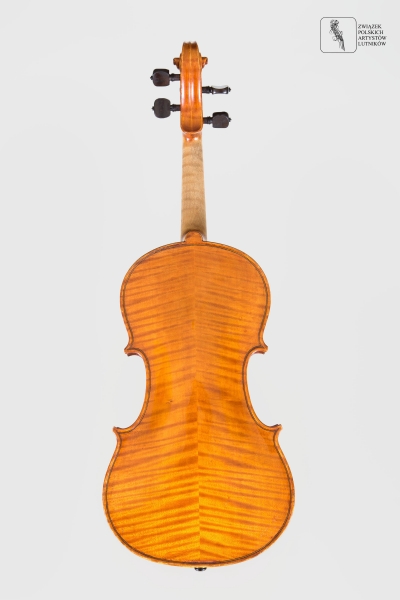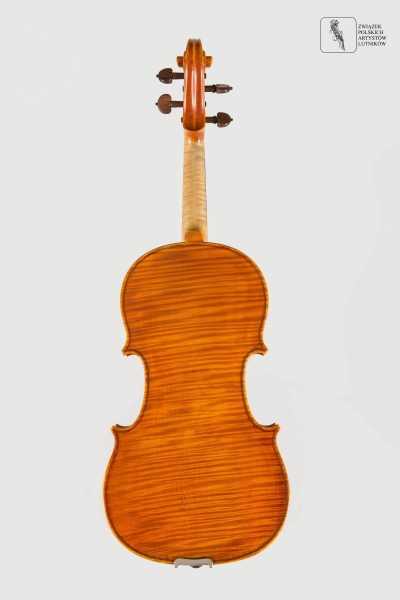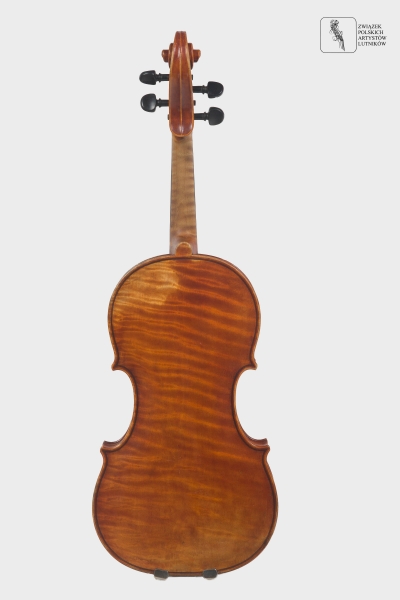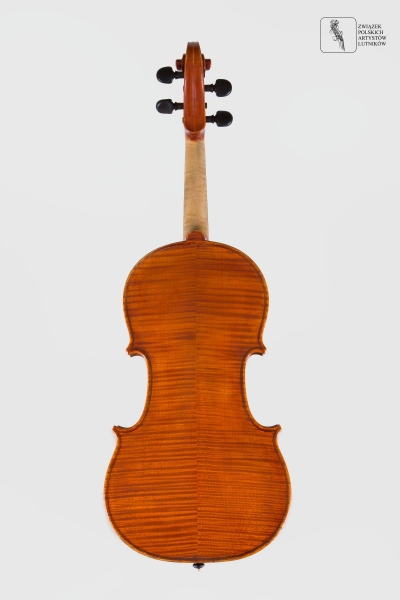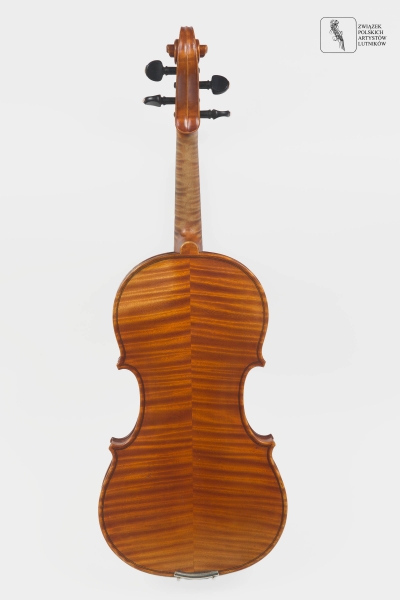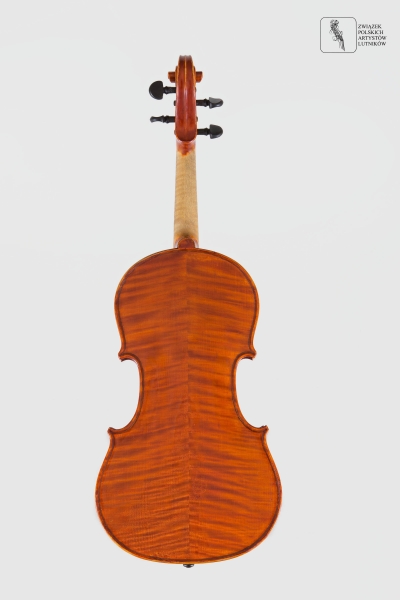International Henryk Wieniawski Violin Making Competition
The Collection of Violins of the Polish Ministry of Culture and National Heritage presented in this database mostly includes instruments that were awarded prizes at subsequent International Henryk Wieniawski Violin Making Competitions held in Poznań. Photographs and catalogue cards of almost all of the violins mentioned in the overview below may be found by browsing the Violins section on the website or searching the database by name.
The history of violin making focuses on the most prominent luthiers. In Poland, the names Groblicz and Dankwart excited the imagination of researchers seeking to discover the obscure beginnings of the art of violin making. Among those fascinated with the art of lutherie was Zdzisław Szulc – a merchant and collector of musical instruments before the war and a colourful figure and promoter of musical life in post-war Poznań. Almost immediately after the war ended in 1945, Szulc started campaigning for the establishment of a museum to hold musical instruments which had survived the war. Szulc himself had managed to salvage around 80 objects from his much larger instrument collection, hiding them in his brother's jewellery shop1. Those extant pieces became the core of Poland's first public collection of musical instruments opened already in 1946 – originally functioning within the Wielkopolskie Museum, now the National Museum in Poznań2. The museum took part in the celebrations of the Chopin Year in 1949, mounting a display of Chopin memorabilia and musical instruments. Exhibited alongside Chopin’s piano from Antonin were violins, which was connected with a violin making competition taking place as part of a festival of art and music schools. The contest was won by Józef Świrek from Katowice (then Stalinogrod) and Marian Niewczyk from Poznań, and became a harbinger of the Henryk Wieniawski Violin Making Competition.
In 1952 the Musical Instrument Museum in Poznań moved to a permanent building, while in 1953 an exhibition called "Violin in Poland" devoted to the history of chordophones in Polish lands was opened in conjunction with the 2nd International Henryk Wieniawski Violin Competition. The showcase attracted unprecedented attention from luthiers and people fascinated with their art. It also inspired the establishment of the Polish Association of Artist Violin Makers, which came into being still in 19533.
Soon after the idea to hold a violin making competition in Poznań emerged. One of its most ardent proponents was Zdzisław Szulc, the founder and curator of the Musical Instrument Museum in Poznań, which held the gems of Polish lutherie and subsequently became the venue of the event. Avidly interested in the instruments of the violin family, Szulc had consolidated around the museum a group of people actively involved in investigating Polish violin making traditions, which go back many centuries back. One of the more exciting hypotheses that fired the imagination of those researchers concerned the Groblicz and Dankwart families, and has not been sufficiently examined to this day. It was in that inspiring atmosphere that the first editions of the Poznań violin making competition took place. The event was an answer to renewed demand for master violins made by crafted luthiers instead of factory made instruments, the need to revive Polish and international lutherie, and to support and further perfect the art of violin making.
The competition was open to active luthiers of all nationalities and ages. Each craftsman could submit more than one instrument, provided that it was the maker's property. It was not allowed to submit violins that had been awarded at other competitions. The rules and regulations made is very clear from the beginning that the jury shall not accept instruments that had not been handmade by an individual craftsman; had eccentric shapes, colours and adornments; whose finishing imitated the appearance of old instruments; which were made of materials other than wood or which were made of wood that had been artificially distressed or chemically treated to look older4.
Originally formulated in 1967, the wording had little changed by the 2011 edition, whose rules and regulations specified that instruments bearing traces of factory processing, having eccentric shapes and colours, intentionally finished to imitate the appearance of old instruments, and made from materials other than wood shall not be accepted in the competition5. Prizes are awarded as a result of a process including a preselection and jury deliberations. Jurors first evaluate an instrument's quality and construction, then the sound. Awarded violins become the property of the Collection of Violins of the Polish Ministry of Culture and National Heritage (marked with a KIL inventory number in our database), becoming available to violinists, including the participants of the Wieniawski violin competitions. This way, the two competitions – for luthiers and violinists – are deeply connected.
1957
The 1st International Henryk Wieniawski Violin Making Competition in 1957 attracted considerable attention of luthiers. As many as 131 violins were submitted from 16 different countries, including the USA, Europe, and the Chinese People's Republic. The jury was headed by Professor Zdzisław Jahnke and was made up of international violinists and luthiers representing the USSR, Romania, Belgium, France, Italy, the German Democratic Republic (GDR), the Federal Republic of Germany (FRG), and Poland, including Irena Dubiska, Eugenia Umińska Tadeusz Wroński, Piotr Kubas, and Feliks Konstanty Pruszak, honorary member of the jury6. The competition unfolded in two stages. To give the jury a chance to evaluate the entries’ tonal qualities, Mieczysław Giżelski, Igor Iwanow, and Edward Statkiewicz played the instruments before the jury. The bar was set high: first prize was not awarded, second prizes went to Josef Vavra (Czechoslovakia) and René Quenoil (France), while Harry Mueller (GDR) and Josef Pötzl from Czechoslovakia won third prizes (KIL-17). Poland's Eugeniusz Gosiewski received fourth prize and one of the special awards, the gold medal of the International Quartet Competition in Liège for the best Polish luthier. Fourth prizes were also awarded to Czechoslovakia's Albert Lang and Germany's Franz Joseph Klier (KIL-18)7. Mieczysław Bielański (Poland) received the Warsaw Philharmonic Award for a violin that was subsequently displayed at an exhibition held by the Glinka Museum of Musical Culture in Moscow in 1988 (KIL-22).
1962
The second violin making competition was held in Poznań in 1962. The jury was headed by Tadeusz Wroński and the event unfolded in three, not two stages. Out of the 140 instruments submitted, 52 had been made in Czechoslovakia. In the process of preselection, 92 violins were accepted to the competition. The final round featured 15 violins, seven of which were built by Czechoslovak luthiers. Two first prizes went to Poland's southern neighbours: Vladimír Pilař and Přemysl Špidlen, who also received medals for producing violins of the best craftsmanship from the Polish Association of Artist Violin Makers. Both instruments were included in the ministerial Collection of Violins, and were lent the very same year to two participants of the Wieniawski violin competition. As a result, Krzysztof Jakowicz won third prize playing Špidlen's violin (KIL-35), while Tomasz Michalak received fourth prize playing Pilař's instrument (KIL-36). As for the the 1962 violin making competition, second prizes were not awarded, yet there were three third prize winners: Přemysl Špidlen for another of his violins along with Italy's Sesto Rocchi and Renato Scrollavezza8.
1967
The third violin making competition held in Poznań in 1967 saw 155 entries. More and more contestants from outside of Europe, including Mexico, Argentina, Japan, or Turkey, were recorded. The jury was again chaired by Tadeusz Wroński. Jadwiga Kaliszewska played the violins from behind a screen for the jury to evaluate. While first prize was not awarded, three luthiers received second prizes: Přemysl Špidlen (KIL-57) and Renato Scrollavezza, who had participated in the event’s previous edition, and António Capela of Portugal (KIL-58). Third prize went to Piotr Kubas (Poland), who also received a special award for the best Polish instrument, while fourth prize was given to António Capela9.
1972
The year 1972 saw the fourth edition of the International Henryk Wieniawski Violin Making Competition. This time 158 instruments from 20 countries were submitted. Tests of the violins' tonal qualities were performed in the first stage of the event (and many of its subsequent editions) by Michał Grabarczyk, prizewinner of the 5th International Henryk Wieniawski Violin Competition (1967). The jury was led by Włodzimierz Kamiński, head of the Polish Association of Artist Violin Makers, who would carry on as the chairman of the for many years to come. First prizes were awarded to two violins made by the patriarch of the Capela violin making family, Domingos F. Capela (Portugal). His son António, one of the prizewinners of the previous competition, won third and fourth prizes. Also awarded fourth prize was Kurt Gütter from Marneukirchen, GDR (KIL-83). Fifth prizes went to Anatoly Kochergin (USSR; KIL-85) and Mieczysław Bielański (Poland). The Golden Groblicz Award for the biggest personality of the competition, launched that year by the National Museum in Poznań, was given to Gio Batta Morassi from Italy10.
1977
As many as 205 violins were submitted to the 5th International Henryk Wieniawski Violin Making Competition by 125 luthiers representing 19 countries. Chaired by Włodzimierz Kamiński, the 1977 jury decided to present the highest accolade to Józef Bartoszek from Zakopane (KIL-91), who thus became Poland's first winner of the competition; he was also awarded a fourth prize. Second (KIL-93) and fifth prize went to Kurt Gütter of the GDR, who had participated in previous editions of the competition. Third (KIL-90) and one of fourth prizes were awarded to Tomáš Pilař (Czechoslovakia), member of a violin making clan whose members would often visit Poznań, who also took home the Golden Groblicz Award. One of the participants was Franciszek Marduła from Zakopane, teacher of Józef Bartoszek, who received one of fifth prizes (KIL-92)11.
1981
Włodzimierz Kamiński continued to serve as the chairman of the competition jury in 1981. The sixth edition gathered luthiers representing 15 countries, who submitted 156 instruments for evaluation. The jury included many of the event's previous prizewinners, such as Józef Bartoszek, Mieczysław Bielański, António Capela, Gio Batta Morassi, or Vladimir Pilař, and two violinists involved with the competition for a long time, Jadwiga Kaliszewska and Zenon Płoszaj. First prize was taken by Ivano Coratti (Italy), while the second went to the first female prizewinner of the competition, Italy's Nadia Mantovani. Jaromir Joo (Czechoslovakia) was awarded both the third prize and a medal of the Polish Union of Artist Violin Makers for the best craftsmanship. Jochen Voigt (GDR) and Anatoly Kochergin (USRR) took a fourth prize each, while Cremona-based Japanese luthier Tetsuo Matsuda (KIL-103) and Canadian Paul Wiessmeyer both won fifth prizes12.
1986
The seventh violin competition in Poznań was held in 1986. There was no change at the helm as Włodzimierz Kamińskiego again acted as the jury's head. Overall, 166 entries were sent in from 17 countries. The first prize again went to a Pole, Jan Bobak, the second to Italy's Lorenzo Marchi, the third to an Jerzy Piórko (Poland; KIL-118), while two fourth prizes were taken by Japanese luthiers, Junji Matsuoka and Shinaya Mochizuki. As always, many special awards were presented to the participants as well. Among them was another member of the Cappella clan, Joaquim, Jerzy Piórko, and Stanisław Król. The Golden Groblicz went to Michał Więckowski (Poland)13.
1991
The 8th International Henryk Wieniawski Violin Making Competition held in 1991 saw 66 entries, including the first Peruvian instrument in the event's history. The jury awarded first prize to Jerzy Piórko from Lubin, Poland. The luthier also received a silver plaque for the best varnish from the Polish Union of Artist Violin Makers. Second prize went to
another Lubin-based craftsman, Tadeusz Słodyczka (KIL-158), while third prize was presented to Stanisław Król from Kraków, Poland (KIL-159). Fourth prizes were taken by Antoni Krupa (Poland; KIL-160) and Udo Kretzschmann (Germany). Norbert Kijanka received the German Association of Violin Makers award for the best Polish participant of the third stage of the competition under 26 years of age and the silver António Cappella medal for the youngest finalist (KIL-154)14.
1996
To select the winner, the jury of the ninth Wieniawski violin making competition in 1996 had to choose between 200 instruments submitted from all over the world. There even was an entry from New Zealand for the first time in the event's history. Perceived as another curiosity were eight violins by Japanese luthiers based in Italy. Following Włodzimierz Kamiński's death in 1993, the man to lead the jury was luthier Józef Bartoszek, who won the 1977 edition of the competition. The task of performing sound tests of the violins was assigned to Bartosz Bryła, prizewinner of the 1981 Wieniawski violin competition, who continued in the job for subsequent editions. First and second prizes were awarded to Simeone Morassi (Italy), son of Gio Batta Morassi and a member of a well-known family of violin makers, whose instruments (KIL-205, KIL-206) scored highest for tonal quality and craftsmanship. Krzysztof Mróz (Poland, KIL-207) also received first prize. Third prizes were presented to Mróz and Giovanni Battista Morassi, the winner's cousin. Fourth prizes went to Gao Tong Tong (China) and Mieczysław Nowobilski (Poland). In conjunction with the event, the Musical Instrument Museum in Poznań mounted an exhibition devoted to the history of violin making in Poland15.
2001
Held in 2001, the tenth edition of the Poznań violin making competition saw 161 entries from 25 countries. The jury worked under Andrzej Łapa. Igor Ulitsky (Russia) received first prize, the Polish Union of Artist Violin Makers medal for the best craftsmanship, and the Silver Fan for the best luthier from the head of the Tokyo Violin Making School. Second prize went to Norbert Kijanka (Poland; KIL-248), while Robert Loska (Poland) received third prize and a the mayor of Poznań award for two best scoring instruments (KIL-245, KIL-249). Fourth, fifth and sixth prizes were taken, respectively, by Magne Kvamme (Norway), Marcin Krupa (Poland), and Giovanni Battista Morassi (Italy). Poland's Andrzej Pancerz was honoured with the Henryk Wieniawski Musical Society medal for the instrument of the best tonal quality.
2006
The jury of the eleventh Wieniawski violin making competition in 2006 was headed by Gio Batta Morassi, famous Italian luthier and former participate of the event. Staring with this edition, the dominance of Asian luthiers stated to show. Out of 146 entries, 99 qualified for the competition. First prize went to Japanese violin maker based in Cremona, Hiroshi Kikuta, who also received the medal for the best tonal qualities. Second prize was taken by Italy's Sandro Asinari (KIL-263), third by another Italian, Alessandro Scandroglio, who was the youngest of all the prizewinners17.
2011
The chairman of the twelfth Wieniawski violin making competition in 2011 was Roger Hargrave. Overall, 180 instruments from 23 countries were submitted. First prize was awarded to Min Sung Kim (South Korea), second to Marcus Klimke (Germany), and third to Ulrike Dederer, representing Switzerland and Germany, who became a juror of the next competition18.
2016
The jury of the thirteenth competition held in 2016 was headed by Raymond Schryer (Canada). Korea's Ji Hwan Park emerged as the winner, receiving both first and second prize. Another second prize was awarded to Krzysztof Krupa (Poland), while third was taken by Philippe Mahu (France). The finalists – Piotr Pielaszek (Poland), Marcin Krupa (Poland), Krzysztof Krupa (Poland), Debora Scianamé (Italy), Gonzalo Bayolo (Spain), Sungdeok Seo (South Korea) – received a range of special awards. The Golden Groblicz Award for the best adornments was presented to Stefan Jarosz (Poland)19. Traditionally, after the competition ended, the Musical Instrument Museum in of Poznań launched an exhibition displaying the best violins.
Even a fleeing analysis of the lives of luthiers participating in the Poznań violin making competitions is beyond the scope of this overview. Nor is there space to provide an exhaustive account of each of the competition's editions. Hopefully, the text serves as a helpful guide to users of the website, showing them one way of exploring the database – that is tracking prizewinning instruments from the Collection of Violins of the Ministry of Culture and National Heritage. Courtesy of the Polish Union of Artist Violin Makers these instruments have been catalogued and photographed for everyone to explore. Also available are their makers' detailed biographies.
Joanna Gul
1. Zdzisław Szulc. Pasja i muzyka, ed. J. Jaskulski, Muzeum Narodowe w Poznaniu, Poznań 2006, p. 10ff.
2. Ibid., p. 23.
3. Ibid., p. 30.
4. Rules and regulations of the 3rd International Henryk Wieniawski Violin Making Competition (1967), Archives of the the Henryk Wieniawski Musical Society of Poznań.
5. Rules and regulations of the 13th International Henryk Wieniawski Violin Making Competition <http://www.wieniawski.com/rules-and-regulations.html> accessed Oct. 2016. These stringent rules are considered excessively limiting by some. For instance, if ever submitted to the competition, Tomasz Panufnik's Polonia violin would have to be rejected instantaneously despite its evident artistic quality.
6. Da capo: 75 Years of International Henryk Wieniawski Competitions, ed. R. Połczyński, Henryk Wieniawski Musical Society, Poznań 2011, p. 192. See the book also for full membership of all juries and full inventory of prizes and distinctions awarded.
7. Ibid., p. 194; archives of the Polish Union of Artist Violin Makers.
8. Ibid., pp. 197–202; archives of the Polish Union of Artist Violin Makers.
9. Ibid., pp. 203–208; archives of the Polish Union of Artist Violin Makers.
10. Ibid., pp. 209–216; archives of the Polish Union of Artist Violin Makers.
11. Ibid., pp. 217–220; archives of the Polish Union of Artist Violin Makers.
12. Ibid., pp. 221–226; archives of the Polish Union of Artist Violin Makers.
13. Ibid., pp. 227–232; archives of the Polish Union of Artist Violin Makers.
14. Ibid., pp. 233–236; archives of the Polish Union of Artist Violin Makers.
15. Ibid., pp. 237–242; archives of the Polish Union of Artist Violin Makers.
16. Ibid., pp. 243–248; archives of the Polish Union of Artist Violin Makers.
17. Ibid., pp. 249–256; archives of the Polish Union of Artist Violin Makers.
18. Website of the Henryk Wieniawski Musical Society of Poznań <http://www.wieniawski.com/xiimkl.html> accessed Oct. 2016.
19. Website of the Henryk Wieniawski Musical Society of Poznań <http://www.wieniawski.com/13ivmc.html> accessed Oct. 2016.
